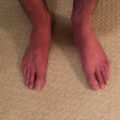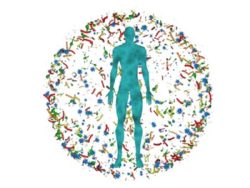Mononucleosis, also known as “kissing disease”, is an infectious disease that most commonly occurs between 15 and 24 years of age. The Epstein-Barr virus (EBV) appears to be responsible but EBV infections are often asymptomatic while some individuals present with the disease. It should be suspected in patients presenting with a sore throat, fever, tonsillar enlargement, fatigue lymphadenopathy (swollen glands in the neck), pharyngeal inflammation, and palatal petechiae (tiny spots of bleeding on the palate). An antibody test is the best initial test for diagnosis with 71 to 80% accuracy. But it has a 25% false-negative rate in the first week of the illness. The illness is unlikely if the lymphocyte count (white cells) is less than 4000 mm3. The presence of antibodies confirms infection but the test is more costly and results take longer. Symptomatic relief is the mainstay of treatment because there is no specific medication that is effective. Rupture of the spleen is an uncommon complication and children are at the highest risk of airway obstruction which is the most common cause of hospitalization from this disease.
To determine the appropriate management of the active individual with infectious mononucleosis, including the problem of diagnosis, determination of an enlarged spleen, and the relationship of chronic fatigue syndrome, creates a risk of exercise at various points in the disease process. Clinical diagnosis of this disease is unreliable and estimates of spleen enlargement are fallible. As mentioned above, the main risks to the athlete are spontaneous rupture of the spleen, signaled by acute abdominal pain, and progression of chronic fatigue. A full recovery of athletic performance is usual within 2 to 3 months of conservative management. Long-term risks to the health of athletes are few.
A total of 200 adolescents, 12-20 years old with acute EBV infection were assessed for possible baseline predictors of long-term chronic fatigue and followed prospectively. Six months after the infection, fatigue was significantly marked by the following associated symptoms; sensory sensitivity, pain severity, functional impairment, negative emotions (anxiety), and verbal memory (correct word recognition). Data are presented on 14 patients with chronic symptoms of disabling fatigue with serologic evidence of active EBV infection.
Personal Experience Treating Mononucleosis
I have posted this experience previously but it bears repeating. My granddaughter came home from school and left with some friends to go white water rafting. She fell in the water and when she got home her fatigue was so great that she went to bed and reportedly “could barely raise her head from the pillow”. Her mother, a nurse, took her to the University hospital where a diagnosis of mononucleosis was made. I do not know what clinical or laboratory markers were used to make the diagnosis. However, I persuaded her parents to bring her to my office where I gave her nutrients intravenously. She quickly returned to school with no fatigue or other symptoms. I cannot claim that the diagnosis was or was not accurate but the fatigue, a salient symptom offered by my granddaughter, had disappeared. I will try to give an explanation below. Surely, if the symptom of fatigue was caused by the effect of the EBV virus, there had to be another factor that assisted the virulence of the virus.
It has become evident to me that naming various diseases is much like mixing apples and oranges. For example, chronic fatigue syndrome (CFS), postural orthostatic tachycardia syndrome (POTS), and mononucleosis all have the same symptoms. They are frequently reported in the medical literature as two or even three diseases, occurring in combination in one individual. The causative agent in mononucleosis is regarded as the Epstein-Barr virus. However, it has been found that this virus can be completely asymptomatic and is found in approximately 90% of the public at various times in life.
A Possible Connection With COVID
It certainly reminds us of a similar situation with Covid-19. We know that this can be asymptomatic or lethal and the only way that this can be explained is by invoking the natural immune defenses of each individual infected. It most sincerely reminds us of the work of Hans Selye who concluded that human diseases were each an example of what he called “the diseases of adaptation”. What he meant by that was that an individual who was attacked by a microorganism was required to muster a significant amount of cellular energy in the organization of defense (immunity).
Fatigue: A Key Indicator of Thiamine Deficiency
I came across an old edition of National Geographic and was intrigued by some text in a section under the heading of “A World of Pain”. In it, “a gentleman by the name of Norris leads a meeting of a support group that he helped found a few years ago through the American Chronic Pain Association” with a goal for informal group therapy by discussion. The group consisted of 10 individuals. One member suffered from severe abdominal pain “that doctors haven’t been able to diagnose” and a woman said that “she suffered from fibromyalgia and complex regional pain syndrome among other issues”. My interest lies in the fact that abdominal pain is a well-known symptom in the vitamin B1 deficiency disease beriberi, by no means pathognomonic but an interesting symptom in view of a comprehensive concept of energy metabolism. Patients with fibromyalgia had higher lactate levels compared to migraine and a control group without recognizing a connection with thiamine deficiency, in spite of the fact that magnesium was found to be analgesic and is a cofactor with thiamine in all its reactions.
From a philosophical point of view, repetition may or may not influence a reader positively. It might well engender a concept that the writer, because of his essential repetitiveness, is overly influenced by his subject, engendering in some readers a sense of disbelief. Without any positive association, I must remind readers that Einstein was completely absorbed by his mathematical equations in dealing with a completely new idea in science. In my view, the idea of energy deficiency in a person’s ability to adapt to a serious form of stress such as an infection creates a logical sense of reality in explaining the variability and similarity of disease expression. If we regard the illness as evidence of a defensive war, the obvious next step is to try to find ways and means of helping this defense. There seems to be only one way of doing this and that is by using the art and science of nutritional elements. Because thiamine and magnesium stand at the very head of energy production, they both become essential ingredients of treatment for any disease. Perhaps that is why I found that an infusion of intravenous vitamins successfully treated virtually any patient that consulted me, regardless of the diagnosis
My research with tetrahydrofurfuryl disulfide (TTFD) has suggested that Mother Nature may well have supplied a curative agent for virtually any illness afflicting mankind, including mononucleosis. TTFD is the synthetic counterpart of allithiamine found in garlic and other members of the allium species. If lack of energy is indeed the cause of any disease as suggested by Selye, then TTFD would be a logical treatment since we have evidence that it is capable of stimulating energy metabolism.
We Need Your Help
More people than ever are reading Hormones Matter, a testament to the need for independent voices in health and medicine. We are not funded and accept limited advertising. Unlike many health sites, we don’t force you to purchase a subscription. We believe health information should be open to all. If you read Hormones Matter, and like it, please help support it. Contribute now.
Yes, I would like to support Hormones Matter.
Photo by Gregory Pappas on Unsplash.
This article was published originally on November 3, 2020.




















